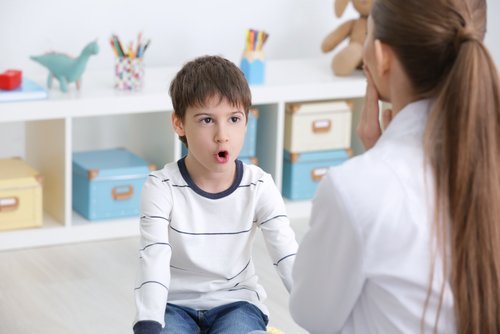All You Need to Know About Dysphasia in Children

Dysphasia in children is a condition that primarily involves difficulties in the use of language. The main characteristic is a noticeable lack of speech or comprehension for the child’s age. It also includes evasive behaviors like not responding, avoiding eye contact, very limited vocabulary or communication through simple gestures.
Dysphasia can sometimes coexist with a slight intellectual disability, however it isn’t always the case. These cases of intellectual disability can be the direct or indirect product of the dysphasia itself.
Delayed treatment impedes communicative development which, in turn, causes underdevelopment of comprehensive logic on a cerebral level. In other cases, a slight intellectual disability can be present from the time dysphasia appears.
Types of dysphasia in children
Expressive dysphasia
Expressive dysphasia is characterized by maintaining intellectual capacities within normal limits. At the same time, it isn’t related to visual or auditory illness.
This type of dysphasia involves a poor ability to imitate word sounds. At the same time, this limits the child’s understanding, giving him or her a very scarce or even null vocabulary.
Expressive dysphasia is actually a motor disability. In other words, there is an underlying difficulty in the execution of words, but not in their comprehension. Therefore, children who suffer from this type of dysphasia usually understand basic verbal commands.
Receptive dysphasia
This type of dysphasia in children involves a low IQ. Typically, the child has a mild intellectual disability or may even be within normal limits. Receptive dysphasia can also coexist along with mild auditory disabilities.
Receptive dysphasia is more sensory in nature. In other words, it involves a difficulty in comprehending stimuli in the environment. This often translates to the use of language with atypical grammatical constructions. For example, the child may use incorrect verb tenses or words without a logical relation to try to communicate.
Mixed dysphasia
Mixed dysphasia involves cases where both expressive and receptive symptoms are present.
Extraordinary symptomology of dysphasia in children
Symptoms that are part of dysphasia, but are not the cause:
- Anxiety disorders
- Social behavior with a notable insecure connotation.
- Underdeveloped thinking/language in relation to the child’s age.
- Low capacity for abstract and comprehensive logic.
- Development of psychoaffective pathologies.
- Learning difficulties.
- Problems with memory.
- Social isolation.
- Low self-esteem.
Of course, the above mentioned symptoms are serious to a greater or lesser degree. However, it’s worth noting that they can be completely avoided with proper and early clinical treatment of the child’s dysphasia.
Initially, dysphasia only affects abilities having to do with communication and verbal comprehension. However, it’s important to mention that it can also extend to reading and writing if it isn’t treated during the child’s first years of life.
Causes of dysphasia in children
There are no clinical triggers for dysphasia, unlike its counterpart, aphasia. Aphasia is similar to dysphasia, but it has an identifiable origen that is either pathological or related to a cranial contusion.
Treatment of dysphasia in children
Treatment of dysphasia in children involves undergoing rehabilitation with a speech therapist. The therapist will attempt to acclimate the child to the stimuli that he or she is unable to perceive because of dysphasia.

Rehabilitation consists of various exercises involving auditory, gestural, and orofacial aspects. The exercises may be separate or dynamically combined, depending on how rehabilitation is advancing. This allows the child to be able to identify, understand and respond to others, at least on a basic level.
Once the stimulus phase is complete, rehabilitation will end with a more didactic phase.
During the didactic phase, the therapist will use drawings and texts to train the child’s semantic, syntactic and morphological abilities. As a result, the child will be able to make efficient use of language and achieve good communication.
Similar conditions to dysphasia
A big obstacle in the identification of dysphasia is its similarity to other conditions like autism, cognitive disabilities, selective mutism, Asperger syndrome, etc.
Once parents take their child to a medical professional, differentiating among different conditions isn’t difficult. These neurological conditions have very singular and easily detectable characteristics. Therefore, specialists can recognize dysphasia in children with relative ease.
The importance of early detection
Dysphasia can cause permanent learning problems and accentuate the loss of cognitive abilities. As a result, mild or even imperceivable cognitive delays can turn into true disabilities that are much more noticeable. The effectiveness of speech therapy will greatly depend on how soon the condition is detected and treated.
All cited sources were thoroughly reviewed by our team to ensure their quality, reliability, currency, and validity. The bibliography of this article was considered reliable and of academic or scientific accuracy.
- Aguilera Albesa, S., & Busto Crespo, O. (2012). Trastornos del lenguaje. Pediatría Integral.
- Aguilera, S., & Botella, M. P. (2008). Trastorno específico del desarrollo del lenguaje. Boletín Servicio Vasco-Navarro Pediatría.
- Lara, E. M. (2011). Trastorno Específico del Lenguaje (TEL). Universidad de Granada.
- Warrington, E. K., & Mccarthy, R. (1983). Category specific access dysphasia. Brain. https://doi.org/10.1093/brain/106.4.859
This text is provided for informational purposes only and does not replace consultation with a professional. If in doubt, consult your specialist.








